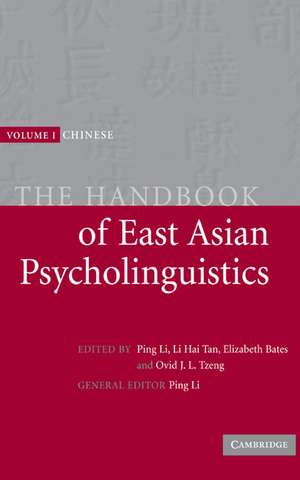The Handbook of East Asian Psycholinguistics: Volume 1, Chinese
Editat de Ping Li, Li Hai Tan, Elizabeth Bates, Ovid J. L. Tzengen Limba Engleză Hardback – 26 apr 2006
Preț: 1270.70 lei
Preț vechi: 1650.26 lei
-23% Nou
Puncte Express: 1906
Preț estimativ în valută:
243.14€ • 254.55$ • 201.19£
243.14€ • 254.55$ • 201.19£
Carte tipărită la comandă
Livrare economică 07-21 aprilie
Preluare comenzi: 021 569.72.76
Specificații
ISBN-13: 9780521833332
ISBN-10: 0521833337
Pagini: 476
Dimensiuni: 161 x 229 x 34 mm
Greutate: 1.1 kg
Editura: Cambridge University Press
Colecția Cambridge University Press
Locul publicării:Cambridge, United Kingdom
ISBN-10: 0521833337
Pagini: 476
Dimensiuni: 161 x 229 x 34 mm
Greutate: 1.1 kg
Editura: Cambridge University Press
Colecția Cambridge University Press
Locul publicării:Cambridge, United Kingdom
Cuprins
Part I. Language Acquisition: 1. Actions and results in the acquisition of Cantonese verbs Sik Lee Cheung and Eve V. Clark; 2. Chinese children's knowledge of binding principles Yu-Chin Chien and Barbara Lust; 3. Chinese classifiers: their use and acquisition Mary Erbaugh; 4. Child language acquisition of temporality in Mandarin Chinese Chiung-chih Huang; 5. Second language acquisition by native Chinese speakers Gisela Jia; 6. Making explicit children's implicit epilanguage in learning to read Chinese Che Kan Leong; 7. Emergent literacy skills in Chinese Catherine McBride-Chang and Yiping Zhong; 8. Basic syntactic categories in early language development Rushen Shi; 9. Growth of orthography-phonology knowledge in the Chinese writing system Hua Shu and Ningning Wu; 10. Interaction of biological and environmental factors in phonological learning Stephanie Stokes; 11. The importance of verbs in Chinese Twila Tardif; 12. Grammar acquisition via parameter setting Charles Yang; 13. Early bilingual acquisition in the Chinese context Virginia Yip; Part II. Language Processing: 14. Word form encoding in Chinese speech production Jenn-Yeu Chen and Gary S. Dell; 15. Effects of semantic radical consistency and combinability on the Chinese character processing May Jane Chen, Brendan S. Weekes, Danling Peng and Qin Lei; 16. Eye movement in Chinese reading: basic processes and cross-linguistic differences Gary Feng; 17. The Chinese character in psycholinguistic research: form, structure and the reader Douglas Honorof and Laurie Feldman; 18. Perception and production of Chinese tones Allard Jongman, Yue Wang, Corinne B. Moore and Joan A. Sereno; 19. Phonological mediation in visual word recognition in English and Chinese In-mao Liu, Jei-tun Wu, Iue-ruey Sue and Sau-chin Chen; 20. Reading Chinese characters: orthography, phonology, meaning and the textual constituency model Charles A. Perfetti and Ying Liu; 21. Processing of characters by native Chinese readers Marcus Taft; 22. L2 acquisition and the processing of Mandarin tones Yue Wang, Joan A. Sereno and Allard Jongman; 23. The comprehension of coreference in Chinese discourse Chin Lung Yang, Peter C. Gordon and Randall Hendrick; 24. Lexical ambiguity resolution in Chinese sentence processing Yaxu Zhang, Ningning Wu and Michael Yip; Part III. Language and the Brain: 25. The relationship between language and cognition Terry Kit-fong Au; 26. Language processing in bilinguals as revealed by functional imaging: a contemporary synthesis Michael W. L. Chee; 27. Specific language impairment in Chinese Paul Fletcher, Stephanie Stokes and Anita M.-Y. Wong; 28. Brain mapping of Chinese speech prosody Jackson T. Gandour; 29. Modelling language acquisition and representation in connectionist networks Ping Li; 30. The manifestation of aphasia syndromes in Chinese Jerome L. Packard; 31. Naming of Chinese phonograms: from cognitive science to cognitive neuroscience Dan-ling Peng and Hua Jiang; 32. How the brain reads the Chinese language: recent neuroimaging findings Li Hai Tan and Wai Ting Siok; Epilogue: a tribute to Elizabeth Bates.
Recenzii
'It is particularly of great use to those who wish to get acquainted with the range of psycholinguistic research concerned with these languages and/or to examine how (language-)specific phenomena are discussed from the psycholinguistic point of view.' Language
Descriere
This 2006 handbook presents a discussion of the psycholinguistic study of Chinese.
